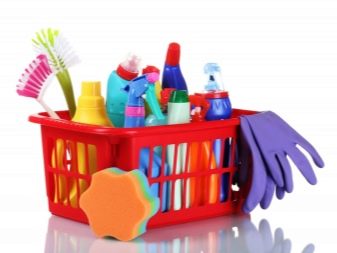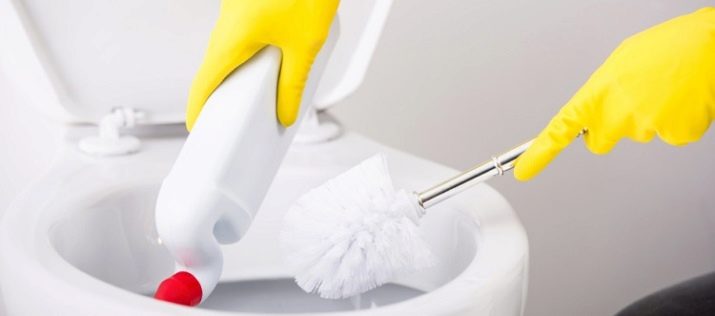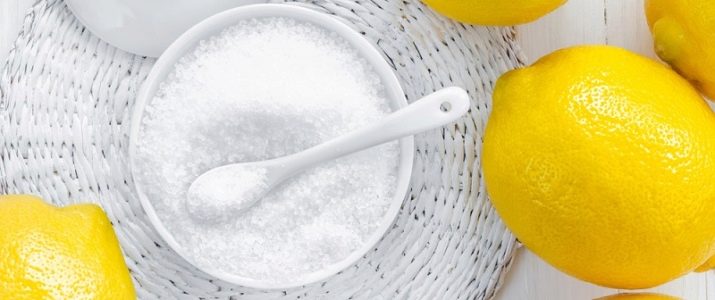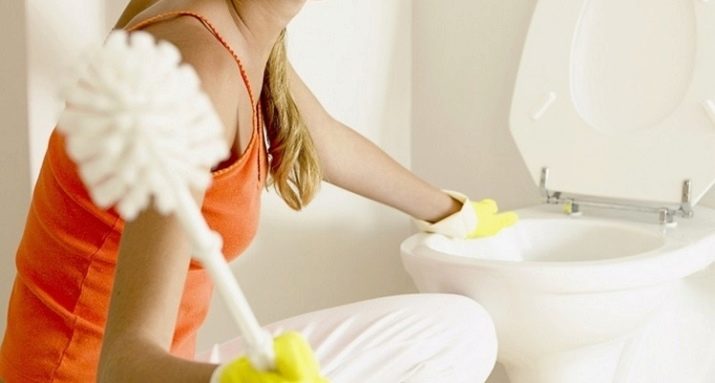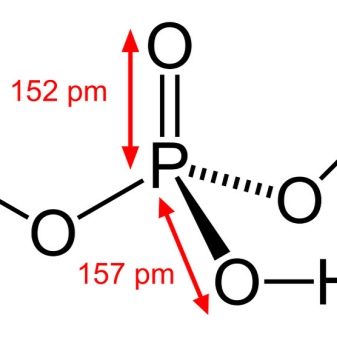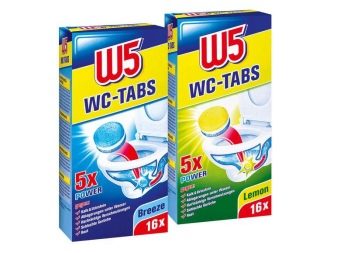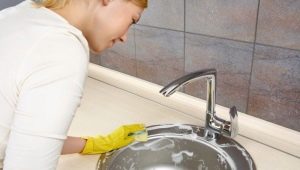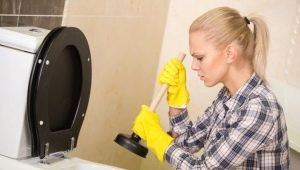How to clean the urinary stone toilet at home?
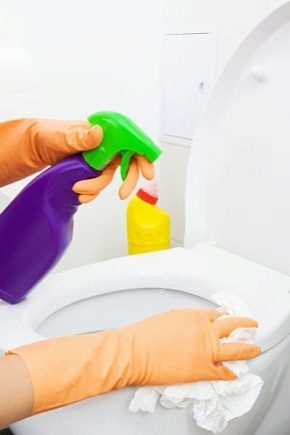
To clean the toilet from the urinary stone plaque, you can use not only purchased products, but also popular recipes. For example, housewives often use soda ash, citric acid, "Whiteness", vinegar, and even some of carbonated drinks. If the plumbing was not cleaned for a long time, then more powerful reagents are used - chemical acids and even electrolyte for batteries. This article will give specific instructions and recommendations on how to use these and other means to clean the toilet bowl from urinary stone.
Causes of pollution
The urinary stone is exactly what we used to call the plaque that appears over time on the inner walls of the toilet bowl. Particularly prone to its accumulation for a long time unchanged plumbing, in a very rough surface, which holds a large amount of lime. Even worse, if the toilet bowl is made of metal, and the pipes have been preserved since Soviet times, all this forms a lot of rust, which also contributes to the formation of the urinary stone. If you can’t change this rarity for modern plumbing equipment, you will have to clean it at least once a week.
What is the ill-fated urinary stone? Most of it is ordinary lime deposits, and microparticles of human waste and rust, retained by the pores of lime, give them a specific smell and tint. This whole mixture is a wonderful environment for life and the rapid reproduction of billions of microorganisms that make the smell even stronger and more unpleasant.
In order to completely clean the toilet wall from the formed deposits, you will have to use the help of strong and rather caustic liquids, so before work to protect the skin of your hands, you must get thick rubber gloves. The effect is directly dependent on the exposure time of the detergent used on the plumbing surface.therefore, it is advisable to carry out treatment late in the evening, and the cleaning itself in the morning.
Pre-close the water supply, then remove the liquid from the cistern and the toilet itself. For its scooping can use a syringe or a small jar.
Folk cleaning methods
Of course, many would like to quickly get rid of the urinary stone in the toilet, using the available means at hand. And there are such funds. Mostly housewives use for this purpose various acids and liquids containing them, as well as alkaline compounds, which include caustic soda or chlorine.
It can be soda (both culinary and soda) or common commercial products such as "White" and "Domestos". It is advisable not to use dry powders for cleaning the toilet bowl, since their particles strongly scratch its walls, which further contributes to the formation of the urinary stone. The following are ways to use these tools.
Lemon acid
Usually, it removes scale from kettles, but it does well with urinary stone deposits. Prepare about 150 grams of citric acid and a sponge slightly moistened with water. Use this sponge to apply the powder on the inner walls of the toilet bowl, especially thickly on the area under the rim. No need to rub, means and so everything will eat.
Now leave it all for at least 5 hours, and preferably all night, after which you clean the toilet with the hard side of a sponge or a regular brush. If the plaque is not completely wiped out, which happens when the toilet has not been cleaned for a very long time, you can repeat the procedure several times until it reaches one hundred percent effect.
To prevent damage to the drain system due to its pollution, you can handle citric acid and the inner part of the drain tank. To do this, fill it with water and pour in a solution of citric acid (100 g of powder per 200 ml of water). Leave to act at night, and in the morning just drain the water.
Citric acid perfectly cleaves lime deposits, which very often cause the failure of the moving parts of the drain system.
Technical oxalic acid
It is usually treated with a surface before applying enamel on them. Externally, oxalic acid is a substance consisting of small translucent granules. To get rid of plumbing from the urinary stone, it must be used in the same way as citric acid (in its usual form or, having previously diluted to the state of a liquid paste using simple water or alcohol). Do not forget about the protection for the hands, as the tool can damage the skin.
Vinegar
For processing, perfect ordinary table. Before the entire inside of the toilet should be well dried. Prepare vinegar and a few scraps of waste tissue. Dip tissue flaps in vinegar and apply on the surface covered with urinary stone. After processing it completely, close the toilet lid and wait at least 5 hours.
After that, remove the flaps and use an unnecessary knife to separate the urinary stone from the walls. Saturated with vinegar, it should almost fall off itself, revealing shiny white enamel. If the lower part of it is still quite tight to the surface, repeat the procedure.
To enhance the effect of vinegar, it can be heated, mixed with soda (1 tablespoon per glass) or iodine (1: 1).
Soda
There are two ways to eliminate urinary stone with soda. Immediately it is worth making a reservation that the second method is not safe, so it can be used only in case of urgent need (if it is impossible to cope with the problem by other methods), as well as in the presence of ventilation in the toilet hood and a tight lid on the toilet. In both cases, we will use mixed in equal proportions soda and baking soda.
In the first (completely safe), you will need a soda mixture and sprayer with 9% vinegar. Soda should be combined with a small amount of water and put the resulting paste on the affected walls of the stone, rub a little. After half an hour, spray vinegar on top and wait until the reaction between them passes. After that, flush the toilet.
The second method, in addition to the previously listed ingredients, involves the use of chlorine-containing liquid bleach, which also needs to be poured into the sprayer. First, wipe the toilet with soda with a damp cloth. After 30 minutes, spray vinegar over soda. After all the carbon dioxide is released (a characteristic mixture foaming), apply a layer of bleach from the sprayer.
During the last stage of treatment, it is advisable not to breathe, you can blindfold and scarf.
The fact is that the reaction of acetic acid and chlorine-containing fluid at the outlet releases a lot of chloride gas, which, when inhaled, causes bronchospasm, intoxication and burns of mucous membranes, so the fan in the hood should already work. After the procedure, as soon as possible, slam the toilet lid and leave the room immediately. After 30 minutes, flush the water and wash the surface with running water.
Carbonated drinks
This is quite an expensive option to clean the toilet, but there are people who prefer it.In fact, the effect of softening the urinary stone with the help of soda is due to the presence in the drink of a large amount of citric acid, which is easy to buy and by itself for an incomparably lower price.
But you need to mess around with the powder, but here it is enough only to pour about 4 liters of soda into the toilet just in the evening and put rags soaked in it. In the morning, the entire urinary stone can be easily scraped off with a sharp object or wiped with a stiff brush.
Using special tools
Today, stores do not have a shortage of emergency and regular toilet cleaning products. Most often they are applied under the bezel, from where they flow down the walls. For a complete cleaning, it is enough to wait no more than an hour, after which you should walk on the treated surface with a brush and rinse everything with water. In particularly advanced cases, such a procedure may not be enough.
Since the choice is really great, Try to get a product in the form of a paste, gel or cream. It should be said that almost all of them contain hydrochloric acid, which explains their high efficiency. If you feel sorry for spending money on expensive commercial products, you can simply buy pure hydrochloric acid and clean the toilet with it (see instructions below).
It is advisable to use powerful chemicals only if all the others did not help, because they involve the manipulation of strong and rather dangerous acids. Wear rubber gloves before work.
Battery Electrolyte
The active ingredient here is sulfuric acid. Pour 200 ml of liquid into the toilet and brush it spread on the walls, put under the rim. Remember to lower the lid. After 15 minutes, drain the water from the tank and rub the walls with a brush. Rinse everything again with water.
Hydrochloric acid
Its concentration should be 33%. When using hydrochloric acid to cleanse the urinary stone, acrid vapors are emitted from it, which in no case can be inhaled. If possible, ensure good ventilation in the room. Use the tool should be the same as the battery electrolyte.
Phosphoric acid (up to 7%)
Pour 100 ml of acid into the cistern and the toilet itself; treat the walls with a brush. Wait a quarter of an hour and drain the water, rub the surface with a brush to separate the urinary stone from it. Once again drain the contents of the tank. During this procedure, the inner walls of the toilet are cleaned, but also the toilet tank, which is especially useful if they have already begun to rust. In addition, phosphoric acid does not corrode rubber and plastic, therefore It can be used in houses with metal pipes.
Preventive measures
There are a few simple rules, following which you will always enjoy the shine and perfect whiteness of the toilet:
- Do not wait for the appearance of visible contamination, clean the toilet at least once in 7 days: put on the walls purchased or one of the above-described folk remedies, and after 30 minutes, clean everything with a brush and flush the water out of the tank.
- The more water passes through the toilet, the more active the urinary stone is. Repair the tank if it is leaking. Ideally, it is desirable to use a design with two buttons of descent, which allow to vary the amount of water supplied, depending on the needs.
- The best prevention of the formation of plaque on the walls of the toilet is the use of plumbing with a very smooth surface, for example, faience or porcelain. If you are going to change the toilet, give preference to just such models.
- There are special pills that need to be put directly into the tank to drain the water. They not only aromatize and disinfect, but also soften hard water, which significantly reduces the rate of formation of urinary stone.
At home, you can clean the toilet quite qualitatively. To clear it inside our advice will help.
You can see in the next video how easy it is to clean the toilet from lime and urinary stone.

